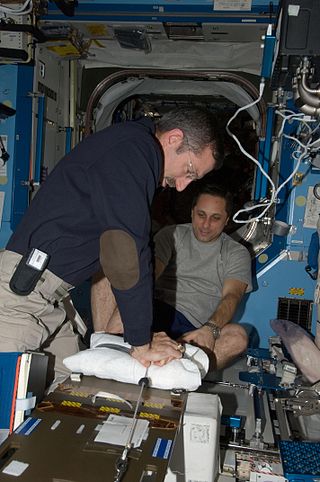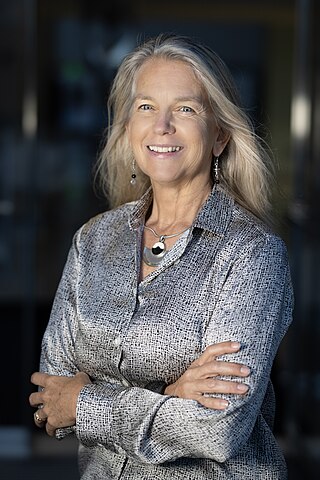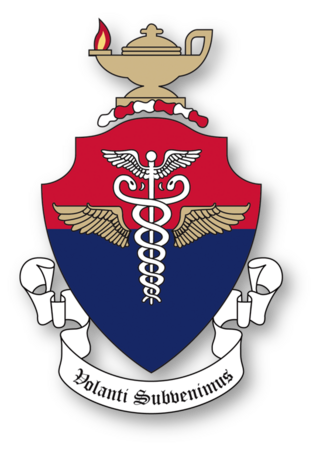Altitude is a distance measurement, usually in the vertical or "up" direction, between a reference datum and a point or object. The exact definition and reference datum varies according to the context. Although the term altitude is commonly used to mean the height above sea level of a location, in geography the term elevation is often preferred for this usage.

A flight surgeon is a military medical officer practicing in the clinical field of aviation medicine, which is also occasionally known as flight surgery.

Aviation medicine, also called flight medicine or aerospace medicine, is a preventive or occupational medicine in which the patients/subjects are pilots, aircrews, or astronauts. The specialty strives to treat or prevent conditions to which aircrews are particularly susceptible, applies medical knowledge to the human factors in aviation and is thus a critical component of aviation safety. A military practitioner of aviation medicine may be called a flight surgeon and a civilian practitioner is an aviation medical examiner. One of the biggest differences between the military and civilian flight doctors is the military flight surgeon's requirement to log flight hours.

A hypobaric chamber, or altitude chamber, is a chamber used during aerospace or high terrestrial altitude research or training to simulate the effects of high altitude on the human body, especially hypoxia and hypobaria. Some chambers also control for temperature and relative humidity.

Hubertus Strughold was a German-born physiologist and medical researcher. Beginning in 1935 he served as chief of aeromedical research for Hermann Göring's Ministry of Aviation and later held the same position with the German Luftwaffe throughout World War II. In 1947 he was brought to the United States as part of Operation Paperclip and went on to serve in a number of high-level scientific posts with the US Air Force and NASA.

Space Medicine is a subspecialty of Emergency Medicine which evolved from the Aerospace Medicine specialty. Space Medicine is dedicated to the prevention and treatment of medical conditions that would limit success in space operations. Space medicine focuses specifically on prevention, acute care, emergency medicine, wilderness medicine, hyper/hypobaric medicine in order to provide medical care of astronauts and spaceflight participants. The spaceflight environment poses many unique stressors to the human body, including G forces, microgravity, unusual atmospheres such as low pressure or high carbon dioxide, and space radiation. Space medicine applies space physiology, preventive medicine, primary care, emergency medicine, acute care medicine, austere medicine, public health, and toxicology to prevent and treat medical problems in space. This expertise is additionally used to inform vehicle systems design to minimize the risk to human health and performance while meeting mission objectives.

Dava J. Newman is an American aerospace engineer. She is the director of the MIT Media Lab and a former deputy administrator of NASA. Newman is the Apollo Program Professor of Aeronautics and Astronautics and Engineering Systems at the Massachusetts Institute of Technology. She has been a faculty member in the department of Aeronautics and Astronautics and MIT's School of Engineering since 1993.
Cambridge Scientific Abstracts was a division of Cambridge Information Group and provider of online databases, based in Bethesda, Maryland, before merging with ProQuest of Ann Arbor, Michigan, in 2007. CSA hosted databases of abstracts and developed taxonomic indexing of scholarly articles. These databases were hosted on the CSA Illumina platform and were available alongside add-on products like CSA Illustrata. The company produced numerous bibliographic databases in different fields of the arts and humanities, natural and social sciences, and technology. Thus, coverage included materials science, environmental sciences and pollution management, biological sciences, aquatic sciences and fisheries, biotechnology, engineering, computer science, sociology, linguistics, and other areas.
Rubicon Foundation, Inc. is a non-profit organization devoted to contributing to the interdependent dynamic between research, exploration, science and education. The foundation, started in 2002, is located in Durham, North Carolina and is primarily supported by donations and grants. Funding has included the Office of Naval Research from 2008 to 2010. Gibson, Dunn & Crutcher has provided pro bono services to assist in copyright searches and support.

The 311th Human Systems Wing is an inactive wing of the United States Air Force. It was stationed at Brooks City-Base in San Antonio, Texas.

The Aerospace Medical Association (AsMA) is the largest professional organization in the fields of aviation, space, and environmental medicine. The AsMA membership includes aerospace and hyperbaric medical specialists, scientists, flight nurses, physiologists, and researchers from all over the world.
Louis Hopewell Bauer was an American medical doctor who founded the Aerospace Medical Association in 1929. Bauer was the first medical director of the Aeronautics Branch of the Department of Commerce which became the Federal Aviation Administration (FAA).

The Microgravity Centre, colloquially known as the "MicroG", at PUCRS university, Porto Alegre, Brazil, was initially created as a laboratory in 1999 by Professor Thais Russomano MD MSc PhD, as the first academic and research establishment dedicated to Space Life Sciences in Latin America. It evolved into a fully multidisciplinary centre in 2006, expanding its areas of research beyond aerospace medicine and engineering, to include pharmaceuticals, biomechanics and physiotherapy, among others.
Mike Monroney Aeronautical Center is a regional office of the United States Federal Aviation Administration on the grounds of Will Rogers Airport in Oklahoma City. With around 7,500 direct federal employees, the Aeronautical Center is one of the Department of Transportation's largest facilities outside the Washington, DC area, and one of the 10 largest employers in the Oklahoma City metropolitan area. It is named for Senator Mike Monroney of Oklahoma, who wrote and sponsored the Federal Aviation Act of 1958.

Civil Aerospace Medical Institute (CAMI) is the medical certification, education, research, and occupational medicine wing of the Office of Aerospace Medicine (AAM) under the auspices of the Federal Aviation Administration Office of Aviation Safety. The Institute's primary goal is to enhance aviation safety.
Illnesses and injuries during space missions are a range of medical conditions and injuries that may occur during space flights. Some of these medical conditions occur due to the changes withstood by the human body during space flight itself, while others are injuries that could have occurred on Earth's surface. A non-exhaustive list of these conditions and their probability of occurrence can be found in the following sources:

The United States Air Force School of Aerospace Medicine (USAFSAM) is the United States Air Force (USAF) organization focused on education, research, and operational consultation in aerospace and operational medicine. USAFSAM was founded in 1918 to conduct research into the medical and physiologic domains related to human flight, and as a school for medical officers trained to support military aviation operations, later coined as flight surgeons. The school supported early military aviation from World War I through the evolution of aviation and into the modern era. USAFSAM conducted medical research and provided medical support for the initial US space operations beginning in 1947 through the establishment of NASA in 1958. After the creation of NASA, USAFSAM continued to actively support civilian and military manned space missions through clinical and physiologic research. USAFSAM is one of the oldest continually operating school for flight surgeons and other operational medical personnel of its kind in the world. USAFSAM is located in Dayton, Ohio at Wright-Patterson Air Force Base, and is part of the 711th Human Performance Wing and the Air Force Research Laboratory (AFRL).

Alice Mary Stoll was an American biophysicist who developed fire-resistant fabric. She was a pioneer in aerospace medicine. She received the Achievement Award from the Society of Women Engineers in 1969.

Naval Medical Research Unit Dayton (NAMRU-D) is a biomedical research laboratory of the United States Navy in Dayton, Ohio. It is one of seven subordinate commands of the Naval Medical Research Command and incorporates two research divisions. The Environmental Health Effects Laboratory was established in 1959 in Bethesda, Maryland, and moved to Dayton in 1976. NAMRU-D's predecessor organization, the Naval Aerospace Medical Research Laboratory (NAMRL), dates back to 1939 when it was established as an aviation medical research unit at Naval Air Station Pensacola, Florida. Pursuant to a 2005 Base Realignment and Closure Commission decision, NAMRL began incrementally relocating to Dayton in late 2010. and was formally disestablished at NAS Pensacola in September 2011. Despite being a Navy activity, NAMRU-D was set up on the grounds of Wright-Patterson Air Force Base at Dayton so it could be co-located with similar U.S. Air Force activities.
Jarnail Singh was a Singaporean physician who focused on aviation medicine. He was known for coordinating the aviation community's response to the severe acute respiratory syndrome (SARS) epidemic outbreak in 2003 and had led the International Civil Aviation Organization's anti-SARS projects for impacted states, studying the spread of communicable diseases via air travel. He also led health studies on pilot fatigue on ultra long-haul flights. He was the chairman of the Civil Aviation Authority of Singapore's Medical Board and the first Asian president of the International Academy of Aviation and Space Medicine.










